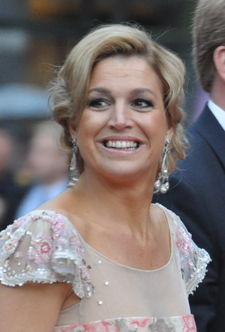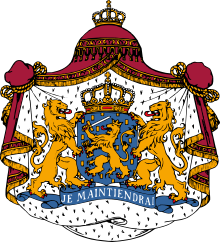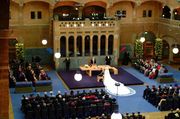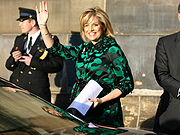Princess Máxima of the Netherlands
| Princess Máxima | |
|---|---|
 |
|
| Princess Máxima at the wedding of Crown Princess Victoria of Sweden, 19 June 2010 | |
| Spouse | Willem-Alexander, Prince of Orange |
| Issue | |
| Catharina-Amalia, Hereditary Princess of Orange Princess Alexia Princess Ariane |
|
| Father | Jorge Horacio Zorreguieta Stefanini |
| Mother | María del Carmen Cerruti Carricart |
| Born | 17 May 1971 Buenos Aires, Argentina |
Princess Máxima of the Netherlands (née Máxima Zorreguieta; born 17 May 1971) is the wife of Willem-Alexander, Prince of Orange, heir apparent to the throne of the Netherlands.
Contents |
Early life and education
The Princess was born as Máxima Zorreguieta in Buenos Aires, Argentina, on 17 May 1971. Máxima is the daughter of Jorge Horacio Zorreguieta Stefanini (born in Buenos Aires, 28 January 1928), a farmer and a politician, who would later be under-secretary of Agriculture under Jorge R. Videla's junta and afterwards President of the Centro Azucarero Argentino (since 1984) and President of the Fundación Vasco-Argentina Juan de Garay (since 1995), son of a Basque Argentine father and an Italian Argentine and a descendant of some Basque nobility, María del Carmen Cerruti Carricart (b. Pergamino, 8 September 1944), daughter of Basque-Argentine parents and who also had some Basque noble ancestry. She has two brothers, a sister and three half-sisters by her father's first wife Marta López Gil (b. 1935), whom he married in 1956, later divorcing.[1]
A former investment banker, she graduated with a degree in Economics from the Universidad Católica Argentina in 1995 before working for large international companies in Finance in Argentina, New York and Europe.
Relationship with Prince Willem-Alexander
Máxima met the heir to the Dutch throne in April 1999 in Sevilla, Spain, during the Seville Spring Fair, also known as the "Feria de abril de Sevilla." This is an important annual event, to which many people from other countries come and dress in typical Spanish Andalusian costume. In an interview, they stated that he introduced himself only as "Alexander," so that she did not know he was a prince. She thought he was joking when he told her he was a Prince. They agreed to meet in New York, where Máxima was working for Dresdner Kleinwort Benson, two weeks later. Their relationship apparently began in New York, but the Princess did not meet the Prince's parents, Queen Beatrix and Prince Claus, for some time.
The news of the couple's relationship and eventual marriage plans caused controversy in the Netherlands. Máxima's father had been the Minister of Agriculture during the regime of former Argentine President Jorge Rafael Videla, a military dictator who ruled Argentina from 1976 to 1981 and who was responsible for many atrocities against civilians (An estimated 10,000–30,000 people disappeared during this and subsequent military regimes before democracy was restored to Argentina in 1983). Jorge Zorreguieta claimed that, as a civilian, he was unaware of the Dirty War while he was a cabinet minister. Professor Baud, who on request of the Dutch Parliament did an inquiry in the involvement of Zorreguieta, concluded that would it have been unlikely for a person in such a powerful position in the government to be unaware of the Dirty War.[2]. However, the research determined that Máxima's father had not been directly involved with the many deaths in question. Even so, his possible presence at the royal wedding was debated for several months.
Dutch Royal Family |
|---|
 |
Extended royal family
* Member of the Dutch Royal House
|
Approval for the marriage was granted by the Dutch parliament (necessary by law for the Prince of Orange to remain heir to the throne), but Máxima's father offered not to attend the wedding. Out of solidarity with her husband, Máxima's mother also remained absent from the wedding on 2 February 2002 in Amsterdam.
Dual citizenship
Máxima was granted Dutch nationality on 17 May 2001. This provoked complaints since such a grant before marriage is not customary in the Netherlands (but required by Dutch law for a royal bride). Under normal circumstances, citizenship takes several years to obtain. The Princess has dual citizenship: Argentine and Dutch.
Máxima was also made Princess of the Netherlands some days before the wedding by Her Majesty Queen Beatrix.
Contrary to popular belief, Máxima remained a Roman Catholic instead of converting to the denomination of the Prince, although they agreed that their children would be raised as Protestants.
Earlier the marriages of Princess Irene and Princess Christina to Roman Catholics, without approval from the Dutch parliament, led to their exclusion from the line of succession to the Dutch throne.
Marriage

The couple announced their engagement on 30 March 2001. Princess Máxima addressed the nation in fluent Dutch during the directly televised broadcast on the occasion of the engagement.
Princess Máxima and Prince Willem-Alexander were married on 2 February 2002 in a civil ceremony in the Beurs van Berlage, Amsterdam which was then followed by a religious ceremony at the Nieuwe Kerk (also in Amsterdam).
Issue
- Her Royal Highness Princess Catharina-Amalia Beatrix Carmen Victoria born 7 December 2003
- Her Royal Highness Princess Alexia Juliana Marcela Laurentien born 26 June 2005
- Her Royal Highness Princess Ariane Wilhelmina Máxima Inés born 10 April 2007
The second names of all three of their daughters are after Dutch queens: Amalia's for her grandmother, Queen Beatrix, Alexia's for her great-grandmother, Queen Juliana and Ariane's for her great-great-grandmother, Queen Wilhelmina.
Princess Máxima is also godmother to two royal babies: Countess Leonore of Orange-Nassau (daughter of Prince Constantijn and Princess Laurentien of the Netherlands) and of Prince Sverre Magnus of Norway (son of Crown Prince Haakon and Crown Princess Mette-Marit of Norway).
Titles and predicate
| Royal styles of Princess Maxima of the Netherlands, Princess of Orange-Nassau |
|
|---|---|
 |
|
| Reference style | Her Royal Highness |
| Spoken style | Your Royal Highness |
| Alternative style | Ma'am |
- Miss Máxima Zorreguieta Cerruti (1971–2002)
- Her Royal Highness Máxima, Princess of the Netherlands, Princess of Orange-Nassau, Mrs. van Amsberg (Since 2 February 2002)
Princess Maxima does not carry the title Princess of Orange. In the Netherlands, the title Prince of Orange is carried by the heir apparent to the throne. When the current Prince of Orange, Prince Willem-Alexander is inaugurated King of the Netherlands, the current Hereditary Princess of Orange, Princess Catharina-Amalia, will become Princess of Orange.
By Royal Decree of 25 January 2002, nr. 41, upon the solemnization of marriage, Máxima Zorreguieta was taken up into the Dutch nobility with the titles Princess of the Netherlands and Princess of Orange-Nassau and the predicate Royal Highness were formally granted to her.
By Royal Decree of 25 January 2002, nr. 42, The Princess was granted her own personal coat of arms and a personal standard.
Work as Princess of the Netherlands

Princess Máxima focuses on the issue of integration of immigrants into Dutch culture. She was a member of a special parliamentary commission, which sought to recommend ways to increase the participation of female immigrants in the workforce. Princess Máxima stresses the importance of learning the Dutch language, as she did, for immigrants to fully participate in Dutch society.
Princess Máxima was a member of the Advisors Group for United Nations International Year of the Microcredit 2005. She undertook a trip to different locations in the world to promote Microcredit, including Africa and various South American countries. She has also attended many UN functions related to the International Year of the Microcredit. She participates in conferences around the world representing the Netherlands. The Princess was granted a seat in the Council of State, the highest advisory body and court of administration (established by Emperor Charles V in 1531). She became a member of the Committee for Ethnic Minority Women’s Participation, has a seat in the board of governors of the Chair on the Management of Diversity and Integration at the Free University of Amsterdam, she (along with her husband) is a patron of the Orange Fund (established to promote social welfare and cohesion in the Netherlands), and also chairs the Board of Trustees of the Prince Claus Chair of the University of Utrecht. The Princess was appointed in September 2009 by the UN Secretary-General, Ban Ki-Moon, as his Special Advocate for Inclusive Finance for Development because of her "extensive knowledge and expertise" on financial matters in developing countries.
Máxima toured all across the Netherlands and visited different countries in the past years on official visits and state visits with the Queen, including Norway, Denmark, Spain, Italy, Belgium, the Baltic States, Uganda, Kenya, Ghana, Brazil, Argentina, Japan, U.S., Turkey, Chile, Morocco, India, Burma, Australia, New Zealand, Aruba, Thailand, Cameroon, Russia, Qatar, Oman, the United Arab Emirates, Antilles and Mexico
She is one of the few royals in the world to be an open supporter of gay rights and was the first royal to attend an LGBT rights conference.[3] The Princess signed an accord at the end of the conference calling for the full acceptance of gays in The Netherlands. "The Princess is in favor of equal rights of all groups in the Netherlands," her spokesperson said. Queen Beatrix has spoken out a number of times in support of LGBT rights.
References
- ↑ Ancestry of Maxima Zorreguieta (b. 1971), William Adams Reitwiesner Genealogical Services
- ↑ Human rights: Zorreguieta vs.humanrights, March 2001
- ↑ FreeForm | Chicago Free Press: Judge Not...
External links
- Princess Máxima (official website of the Dutch Royal House)
- Reina Máxima- Biography, news, fashion,etc about Princess Máxima non-official website, in Spanish, English and Dutch
- Ancestry of Maxima Zorreguieta (b. 1971)
- Royal House of the Netherlands
- Hello Magazine profile
- Royalty Magazine on Princess Maxima
- Gallery of Princess Maxima on RoyalImages
- Year of Microcredit
|
|||||
|
||||||||||||||||||||